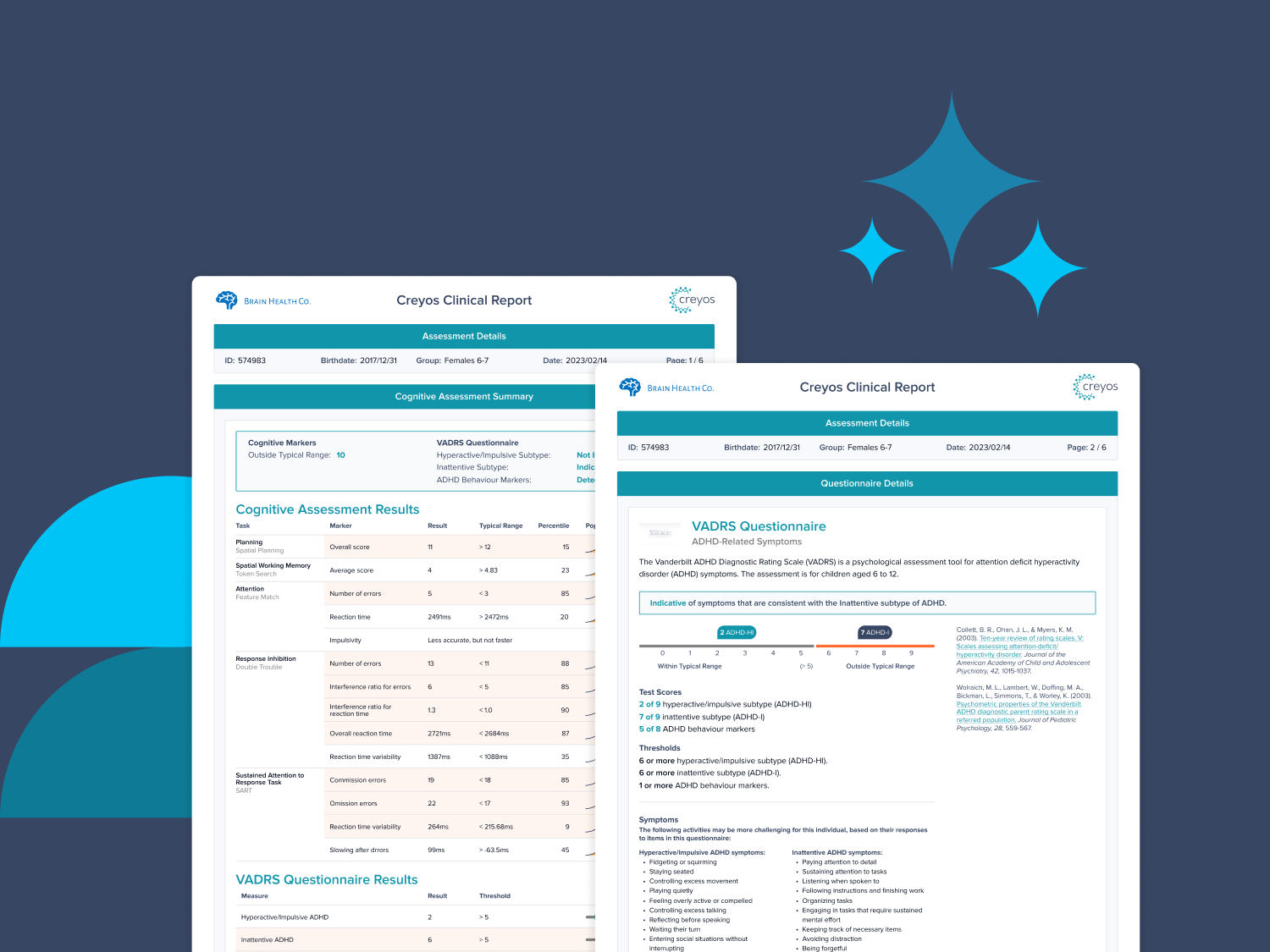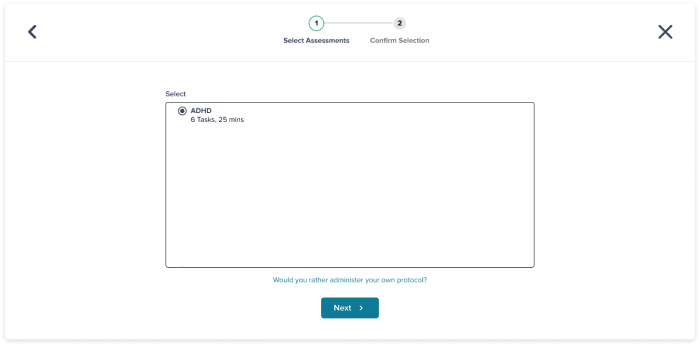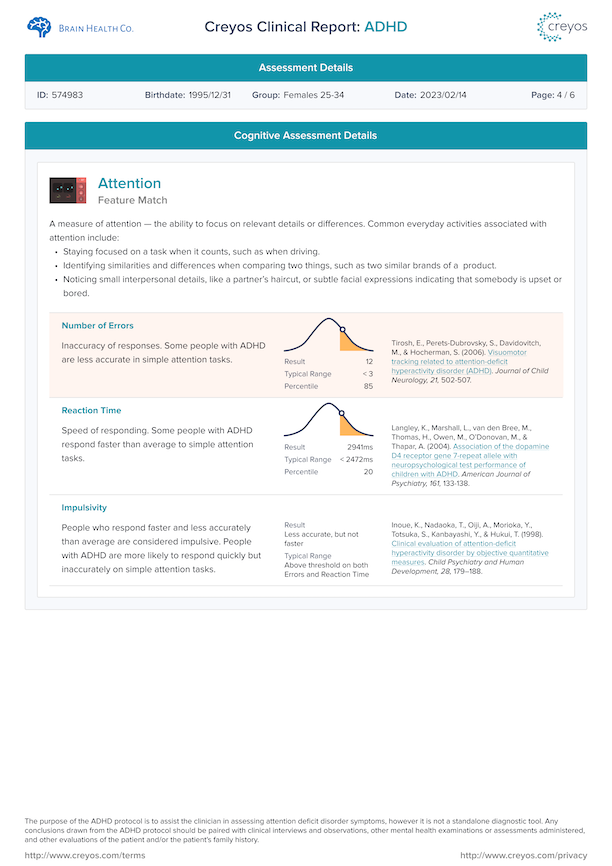
The Creyos ADHD Cognitive Assessment and Automated Report
Published: 30/10/2025 | 10 min read
Written by: Sonia Urlando, Senior Content Marketing Manager
Reviewed by: Mike Battista, Director of Science & Research
The prevalence of attention deficit hyperactivity disorder (ADHD) is growing as public awareness increases and diagnostic criteria evolve. As a result, clinicians are facing more requests from patients for ADHD testing, for both child and adult ADHD. Widespread awareness, open conversations, and reduced stigma are all positives, but more patients can mean a higher risk of overdiagnosis.
So the pressure is on healthcare providers to offer confident, efficient, and accurate diagnoses. With a lot of subjective information out there, clinicians have an opportunity to use objective measures to give patients clear answers about the nature of their symptoms, evaluate their cognitive performance and mental health, and identify a referral or treatment plan.
The Diagnostic and Statistical Manual of Mental Disorders (DSM) outlines criteria for diagnosing ADHD, but subjective evaluation of symptoms is often not enough for healthcare professionals to confidently assess patients and diagnose ADHD. To meet the difficulty of this rising demand, Creyos has created the ADHD Cognitive Assessment and Report.
This report improves patient experiences and outcomes, while offering healthcare professionals the confidence that comes with an assessment tool that is:
- Scientifically validated
- Measures cognitive markers of ADHD
- Provides objective measures to complement self-reports and clinical interviews
- Effective for ongoing, longitudinal testing
- Can be administered either remotely or in person
- Is effective for assessing patients of all ages

The Rise of Attention Deficit Hyperactivity Disorder (ADHD)
Current Research on the Prevalence of ADHD
Attention-deficit hyperactivity disorder is characterized by difficulty paying attention, impulsivity, restlessness, and other difficulties that may affect a person’s life with varying severity. This can include problems remembering appointments, careless mistakes, difficulty concentrating, trouble staying organized, feeling overly active, trouble wrapping up tasks, and more.
ADHD is growing in recognition and prevalence, becoming a major concern for mental healthcare providers. National population surveys show an increase in the prevalence of ADHD, from 6.1% to 10.2% in the 20-year period from 1997 to 2016.
On one hand, there are patients whose diagnoses undeniably require treatment. On the other hand, some providers may worry about the risk of overdiagnosis and overprescription of stimulants. Treatment consideration needs to be carefully weighed along with potential adverse outcomes.
Other studies are exploring whether instances of ADHD have increased since the onset of the COVID-19 pandemic in 2020. Some experts cite causes such as a lack of routine during lockdowns, as well as anxiety about COVID or jobs. There are increasing instances of adult ADHD self-reports that physicians are having to assess and validate.
Challenging the Status Quo of Adult ADHD Symptoms Assessment
Patients want to know—what assessments are used when diagnosing attention deficit hyperactivity disorder? With the availability of social media information, a person who identifies with ADHD symptoms might first turn to a Google search for “ADHD test online,” seeking to validate their experience.
The many online ADHD tests available to the general public aren’t equal to an official diagnosis, but these ADHD tests remain tempting for people struggling with attention, short-term memory, and impulsivity. Patients might feel hesitant to bring their concerns to a clinician because of the long and costly process typically involved in ADHD diagnosis, including many challenging steps:
- 6 to 8 month referral and booking period wait time.
- 1 to 3-hour neuropsychiatric assessment.
- Out-of-pocket expenses for health plan members and all patients.
Some screening tools can be found for free online. Short self-report screening scales have their place, but they are designed to be administered and interpreted by healthcare professionals as traditional pen-and-paper questionnaires.
But how accurate and effective are these tools? Some questionnaires have strong validity, such as the Adult ADHD Self Report Scale (ASRS v1.1), developed to follow the DSM-IV criteria from the American Psychiatric Association. Alone, this assessment is brief and accurate, but it is ultimately subjective and easy to manipulate, so it may not be enough to justify an ADHD diagnosis.
Using only self-reported perceptions and subjective measures, it can be challenging to determine if genuine symptoms of inattention are coming solely from ADHD, comorbidities, another mental health disorder like anxiety or depression, or another condition altogether.
ADHD diagnosis often also requires a patient’s academic records, since the DSM-5 dictates that patients must have experienced symptoms before the age of 12, and in two or more settings. But for adults getting diagnosed later in life, getting those records can be impossible. The standard process often leaves all parties wanting more concrete information.
The Creyos ADHD Cognitive Assessment and Report
What is the Creyos ADHD Assessment Tool?
The Creyos ADHD Cognitive Assessment and Report is a condition-focused protocol that combines the value of subjective, industry-standard questionnaires with the power of objective cognitive testing.
Specifically, this assessment involves five objective Creyos cognitive tasks that examine 14 specific markers of ADHD. It highlights whether the individual is within or outside the typical performance range for each when compared to a representative sample of the general population, making it easy to identify atypical performance on markers associated with ADHD.
What Does the Assessment Tool Include?
Our pre-built ADHD evaluation is different from other protocols used in Creyos.
It is made up of:
- Four cognitive tests that efficiently measure aspects of attention and executive function.
- The Sustained Attention to Response Task (SART), a short, continuous performance task.
- Industry-standard, age-appropriate questionnaires (optional).
How Long Does ADHD Testing Take?
The Creyos ADHD Cognitive Assessment takes less than 25 minutes to complete, making it easy for patients to be evaluated in the appropriate setting for focus, either in the clinic or at home. Patients taking the assessment from their home have the ability to have whatever support person they need present, like the person’s spouse, a close relative, or a parent or guardian.
What are the Benefits of the Creyos ADHD Assessment?
The protocol features the SART, a 6-minute task within the family of continuous performance tasks commonly used with ADHD populations. The entire ADHD assessment is pre-built and tailored to the condition with appropriate scales, so a healthcare professional can easily administer the tasks and produce an objective, precise evaluation.
As with all Creyos Health evaluations, an easy-to-interpret report is instantly generated upon completion. The ADHD report you’ll receive is:
- Scientifically validated and objective.
- Based on extensive research, over 100 scientific studies were reviewed to identify the markers most strongly linked with ADHD.
- Conveys performance with respect to the typical range on ADHD markers, in addition to specific percentile ranks.
The Science Behind The Creyos ADHD Test
How We Built the ADHD Assessment
In speaking to healthcare providers, we consistently heard the need for an objective clinical report focused on child and adult ADHD. Our solution became clear: Use the latest neuroscience, drawn from decades of research, to develop a fast and efficient ADHD-focused protocol that results in a comprehensive, yet easy-to-interpret, report.
This ADHD protocol also draws from existing assessments and rating scales, including:
- The Vanderbilt ADHD Diagnostic Rating Scale, or VADRS
- The Strengths and Weaknesses of Attention-Deficit/Hyperactivity Symptoms and Normal Behavior Scale, or SWAN
- The Adult ADHD Self Report Scale (ASRS v1.1)
To dive even deeper into the science behind the Creyos ADHD Cognitive Assessment, download the Creyos ADHD Clinical Protocol Science Guide.
What Are the 14 Markers of ADHD?
The Creyos ADHD Cognitive Assessment is focused on 14 markers—specific cognitive performance metrics within Creyos tasks that are associated with an ADHD diagnosis. The evaluation can also be tailored to include age-appropriate questionnaires for adults and children.
To find markers associated with ADHD, Creyos examined over 100 peer-reviewed papers in scientific journals and found:
- Ten markers derived from four existing Creyos cognitive tasks (Spatial Planning, Token Search, Feature Match, and Double Trouble).
- Four more markers derived from the Sustained Attention to Response Task (SART), a task available exclusively as part of the Creyos ADHD Cognitive Assessment.
What is the SART?
The SART is a common task used with ADHD populations, and is part of the continuous performance test family—that is, tasks that measure attention and response inhibition over longer periods of time.
As outlined in depth in the Creyos ADHD Clinical Report Science Guide, the SART has proven to be a valid and reliable measure of sustained attention. It specifically measures the ability to sustain mindful, conscious information processing, even in repetitive, boring, or distracting situations.
Completing the SART is simple: numbers flash on the screen, and patients must press the spacebar or click the "Go" button for all numbers except the number 3.

Using the ADHD Assessment Tool in Your Practice
Using a comprehensive assessment tool like this one allows providers to gain critical insight into the cognitive skills of their patients, including their working memory, attention, and response time. Automatically generated results are detailed and easy to interpret, so that providers can spend more of their valuable time with patients and less time doing administrative work.
How to Use the Creyos ADHD Cognitive Assessment
The complete Creyos ADHD Cognitive Assessment and Report only takes 25 minutes to complete and includes a combination of cognitive tests and industry-standard questionnaires. The assessment uses the ASRS v1.1 Part A for adults, the SWAN for patients under 18, and the VADRS for patients 6-12. This lets providers combine the power of objective cognitive testing with the important subjective information gained from self-reports.
1. Click "Start Protocol"
Within the Creyos platform, navigate to the Patient Details page. Once there, start a protocol as you normally would.

2. Choose Your Administration Method
Like with all Creyos assessments, the test can be administered remotely or in person. Choose how you would like to administer the assessment and send a link or an email to your patient to complete the assessment either in the clinic or at home.

3. Choose Custom or Condition-Focused
A new screen will appear with the option to choose between two types of protocols.
- Selecting "Administer Your Own Protocol" will take you down the familiar path of either choosing an existing protocol you have created or creating a custom protocol on the fly.
- Selecting "Choose A Condition-Focused Protocol" will allow you to administer the pre-built ADHD protocol.

4. ADHD Protocol
On the next page, select the ADHD assessment from the available condition-focused protocols.
If you’d like to administer a custom assessment instead, you can also navigate back to a custom protocol flow by clicking "Would you rather administer your own protocol?" You can then assemble your own set of tasks and questionnaires.

5. Add Questionnaire
Next, you will have the chance to review the cognitive tasks included in the assessment, as well as the time required to complete the entire evaluation.
Regardless of what is added, the complete protocol should take 25 minutes at most.

If you leave the ADHD Questionnaire switch on, an age-appropriate questionnaire will also be automatically included, alongside the scientifically validated cognitive tasks that are proven to correlate with ADHD via peer-reviewed academic papers.

How to Interpret the ADHD Assessment Score
Once your patient finishes their assessment, you'll be able to access a simple, easy-to-read report focused on ADHD in the same ways as you always do—right from the patient’s details page or the general reports page. You’ll get a unified report that offers a summary, symptoms, rating scales, plus a deeper dive into performance on each task.
Report Summary Page
The first page of the Creyos ADHD report provides an overview of quick-to-interpret clinical insights. The executive summary shows cognitive assessment results and highlights rows in orange to flag when a marker is outside the typical range. This gives you an easy way to review the information that matters most.
Typical or Outside the Typical Range
Each marker has a threshold used to determine if a patient’s scores fall outside the typical range. You can find these details under the Typical Range column.
The typical range corresponds to the performance of people who are not diagnosed with ADHD. Outside the typical range corresponds, statistically speaking, to the patient’s performance being one standard deviation away from the mean, in the same direction as people diagnosed with ADHD in published studies.
Note, being outside of the typical range can be a result of scores being either higher or lower than average, depending on the marker.
Optional Questionnaire Scoring
With the inclusion of an ADHD questionnaire, like the ASRS Part A, SWAN, or VADRS, a total score will be calculated and compared to a rating scale threshold for ADHD symptoms.
These self-reported questionnaires combine subjective input from the patient with a systematic method of assessing objective performance and recording symptoms over time.
Here is what the VADRS summary report would look like:
.png?width=612&height=792&name=report-details-vadrs%20(1).png)
Behaviors tied to each individual response that indicate ADHD symptoms are also highlighted in the Questionnaire Details section. This allows you to quickly see specific behavioral problems or issues that the patient is experiencing.
Report Details Section
The Cognitive Assessment Details section provides additional context behind each task and its associated markers, allowing you to evaluate how close or far away from the performance threshold the individual scored. Also included on the Details pages are references that speak to the validity of each marker in the report:

For a deep dive into the Creyos ADHD report, download the Creyos ADHD Clinical Report Interpretation Guide.
Using the Creyos ADHD Cognitive Report for Reimbursement
Automatically generated reports from Creyos are detailed and precise to make reimbursement documentation easier than ever. Providers who qualify for reimbursement can leverage these detailed reports to reduce their administration time, increase their ROI, and put time back into their busy schedules. Learn more about using Creyos for reimbursement in our Reimbursement Guide.
Start Using the ADHD Assessment and Report in Your Practice Today
With this protocol and report, healthcare professionals can better respond to patients’ questions and concerns about potential attention deficit hyperactivity disorder (ADHD) diagnosis, determine the need for medication or other interventions, and monitor adult and child ADHD symptoms with age-appropriate data. It’s clear that as greater awareness and prevalence of ADHD emerge, assessments are needed that can provide an objective, scientifically backed, and comprehensive look at the cognitive deficits associated with ADHD.
Frequently asked questions
Do attention deficit hyperactivity disorder (ADHD) medications and other interventions affect cognitive testing performance?
Can the Creyos ADHD assessment be completed remotely?
What age groups is the Creyos ADHD assessment suitable for?

Reviewed by Mike Battista, Director of Science & Research at Creyos
Mike Battista specializes in brain health, cognition, and neuropsychological testing. He received his PhD in personality and measurement psychology at Western University in 2010 and has been doing fun and useful stuff in the intersection between science and technology ever since.

.png?width=2400&height=1256&name=Dr.%20Ozan%20Case%20Study%20-%20Quote%201%20(1).png)
.gif?width=600&height=338&name=9_report_from_reports_landing%20(1).gif)
